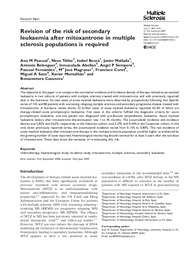Título :
Revision of the risk of secondary leukaemia after mitoxantrone in multiple sclerosis populations is required |
Autor :
Pascual, Ana M
Téllez, Neus
Casanova, Bonaventura 
Perez-Sempere, Angel 
Bosca, Isabel
Mallada, Javier
Fernández, Pascual
Montalbán, Xavier
Belenguer, Antonio
Abellán, Inmaculada
Magraner, María José
Coret, Francisco
Sanz, Miguel A
Montalbán, Xavier |
Editor :
SAGE Publications |
Departamento:
Departamentos de la UMH::Medicina Clínica |
Fecha de publicación:
2009-10 |
URI :
https://hdl.handle.net/11000/30614 |
Resumen :
The objective in this paper is to compare the cumulative incidence and incidence density of therapy-related acute myeloid
leukaemia in two cohorts of patients with multiple sclerosis treated with mitoxantrone, and with previously reported
data in the literature. Six new cases of acute myeloid leukaemia were observed by prospectively following two Spanish
series of 142 and 88 patients with worsening relapsing multiple sclerosis and secondary-progressive disease treated with
mitoxantrone. A literature review shows 32 further cases of acute myeloid leukaemia reported, 65.6% of which are
therapy-related acute promyelocytic leukaemia. Five cases in the cohorts fulfilled the diagnostic criteria for acute
promyelocytic leukaemia, and one patient was diagnosed with pre-B-acute lymphoblastic leukaemia. Acute myeloid
leukaemia latency after mitoxantrone discontinuation was 1 to 45 months. The accumulated incidence and incidence
density was 2.82% and 0.62%, respectively, in the Valencian cohort, and 2.27% and 0.44% in the Catalonian cohort. In the
only seven previously reported series, the accumulated incidence varied from 0.15% to 0.80%. The real incidence of
acute myeloid leukaemia after mitoxantrone therapy in the multiple sclerosis population could be higher as evidenced by
the growing number of cases reported. Haematological monitoring should continue for at least 5 years after the last dose
of mitoxantrone. These data stress the necessity of re-evaluating this risk
|
Palabras clave/Materias:
chemotherapy
haematological study
incidence study
mitoxantrone
multiple sclerosis
secondary leukaemia |
Área de conocimiento :
CDU: Ciencias aplicadas: Medicina |
Tipo documento :
application/pdf |
Derechos de acceso:
info:eu-repo/semantics/openAccess
Attribution-NonCommercial-NoDerivatives 4.0 Internacional |
DOI :
https://doi.org/10.1177/1352458509107 |
Aparece en las colecciones:
Artículos Medicina Clínica
|
 La licencia se describe como: Atribución-NonComercial-NoDerivada 4.0 Internacional.
La licencia se describe como: Atribución-NonComercial-NoDerivada 4.0 Internacional.
.png)
